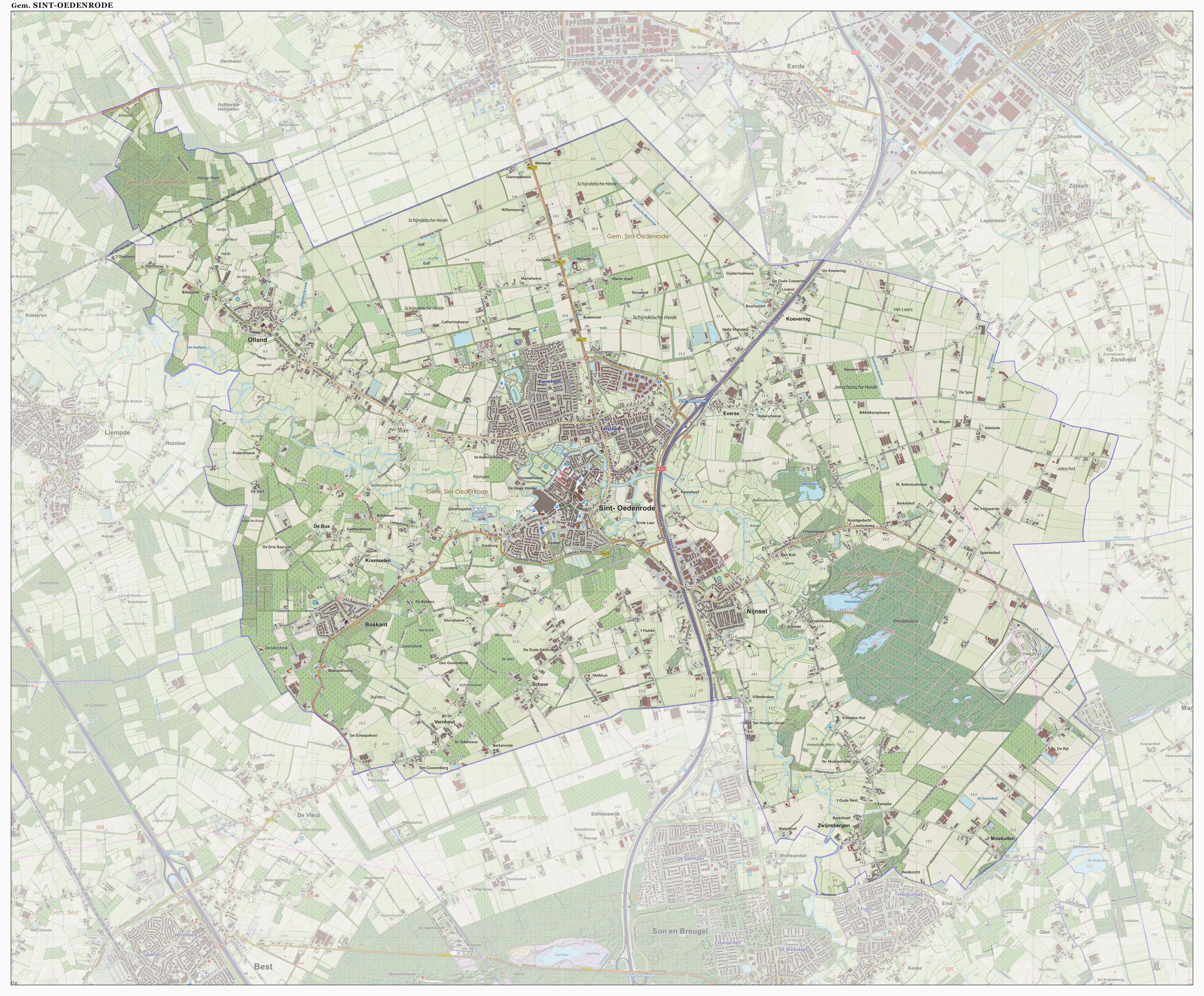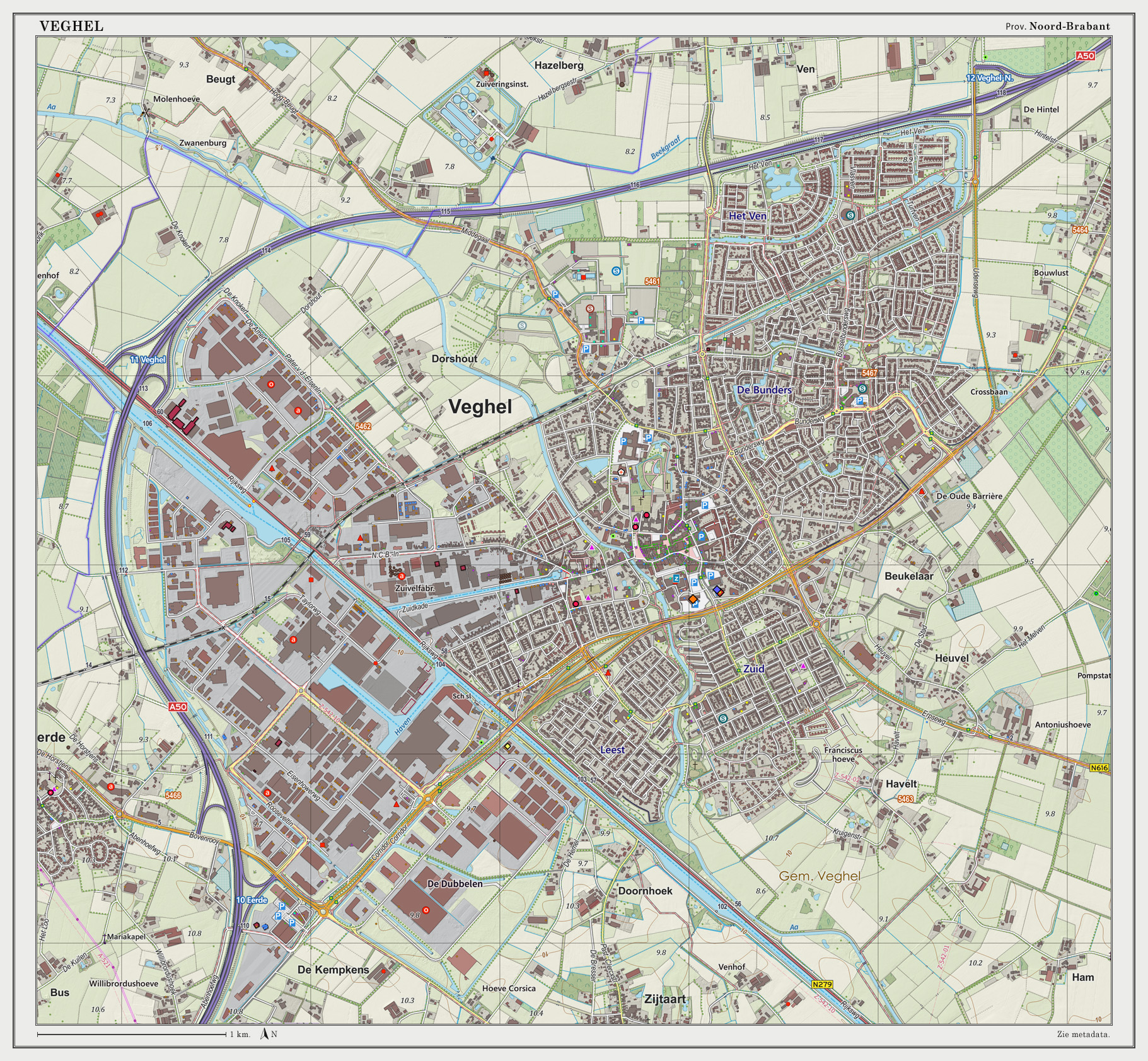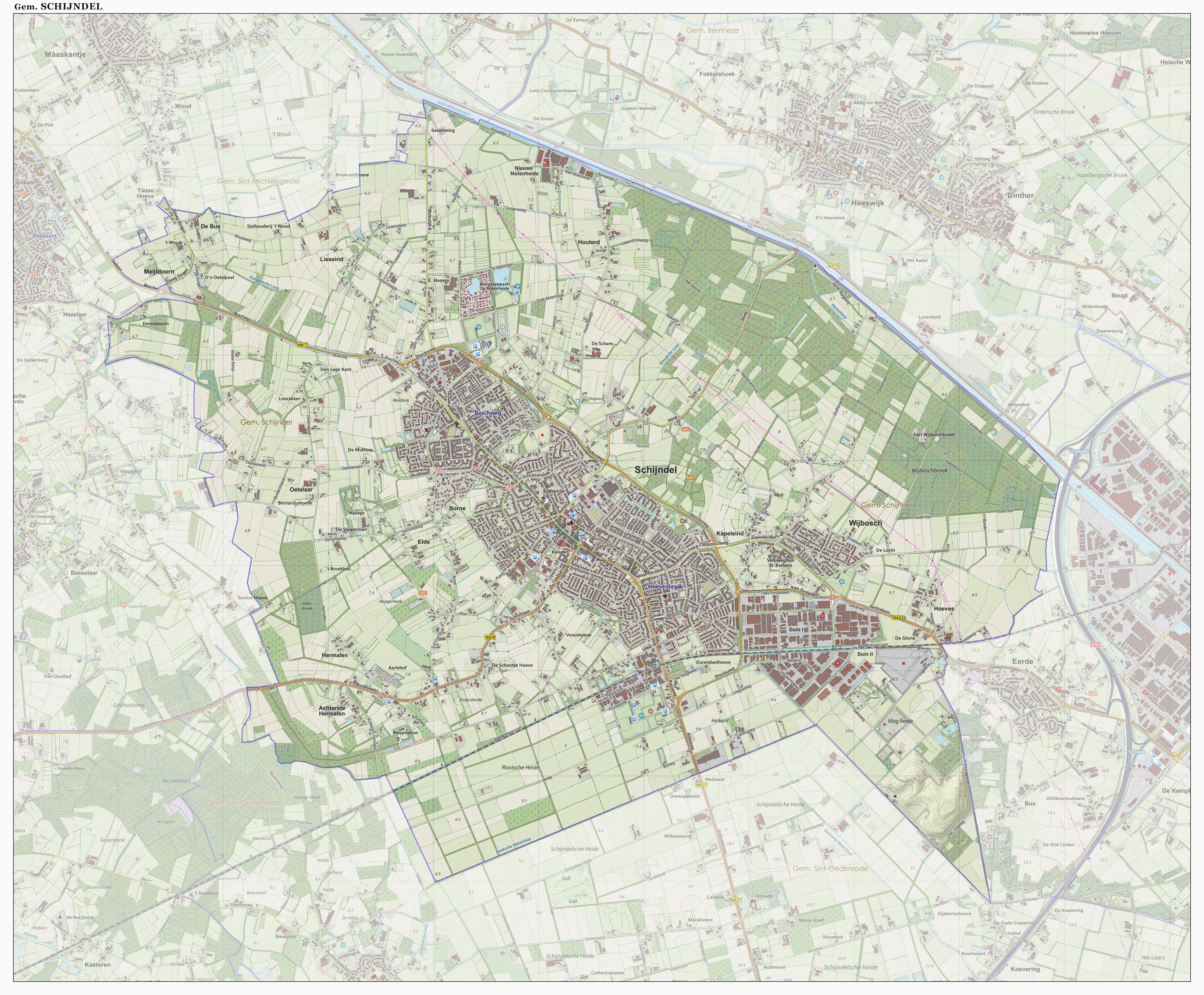|
Sint-Oedenrode
Sint-Oedenrode () is a town in the province of North Brabant. Sint-Oedenrode is a moderately urbanized town in the Meierij of 's-Hertogenbosch. Sint-Oedenrode had an unknown population as of and has an area of . On 1 January 2017 Sint-Oedenrode, together with Schijndel and Veghel, merged into a new municipality called Meierijstad creating the largest municipality of the province North-Brabant in terms of land area. The municipality traditionally had " vrijheidsrechten" (a predecessor of city rights), since 1232, until the abolishment of the privileges and introduction of the Municipalities Act in 1851. In those feudal times Sint-Oedenrode was referred to as a "Vlek" (market town). Today it is still a large town. From southeast to northwest, the town is split by the river Dommel. Population centers The municipality Sint-Oedenrode consists of several quarters and hamlets: * 11 quarters in Sint-Oedenrode and 3 hamlets ("Everse", "Koevering" and "Kremselen") * 1 quarter in Bos ... [...More Info...] [...Related Items...] OR: [Wikipedia] [Google] [Baidu] |
Meierijstad
Meierijstad () is a municipality in the province of North Brabant. The municipality is the result of a merger between the municipalities Schijndel, Sint-Oedenrode and Veghel in 2017. After the merger it became the largest municipality in terms of land area of North Brabant (surpassed by Altena, North Brabant, Altena in 2019). The town of Veghel hosts the town hall, while the municipal council holds its meetings at the former town hall of Sint-Oedenrode. Population centres Topography ''Dutch topographic map of the municipality of Meierijstad, 2020'' Notable people * Hendrik Herp (died 1477) a Dutch or Flemish Franciscan and a writer on mysticism * Pieter de Josselin de Jong (1861 in Sint-Oedenrode – 1906) a Dutch painter from North Brabant * Lou Tellegen (born 1881 in Sint-Oedenrode – 1934) a Dutch stage and film actor, film director and screenwriter [...More Info...] [...Related Items...] OR: [Wikipedia] [Google] [Baidu] |
Dommel
The Dommel is a small river in Belgium and the Netherlands, left tributary of the Dieze. It is 120 km long, of which 85 km in the Netherlands. The Dommel takes in water from the Keersop, Tongelreep, Run, Gender and Kleine Dommel streams and merges at 's-Hertogenbosch with the Aa stream to form the river Dieze, which subsequently flows towards the Meuse. The main cities and towns along the Dommel's course are Peer, Neerpelt, Valkenswaard, Dommelen, Eindhoven, Son en Breugel, Sint-Oedenrode, Boxtel, Sint-Michielsgestel and 's-Hertogenbosch. Drainage basin The drainage basin of the Dommel belongs to that of the Meuse. To the west of is the basin of the Donge, which also belongs to that of the Meuse. To the south the basin of the Dommel borders that of the Schelde. To the east is that of the Aa. Further to the south a number of rivers flow into the Meuse much further upstream. History Former glory The Dommel often looks like a brook nowadays, but it has many geographical ... [...More Info...] [...Related Items...] OR: [Wikipedia] [Google] [Baidu] |
Veghel
Veghel () is a town and a former municipality in the southern Netherlands. On 1 January 2017 Veghel, together with Schijndel and Sint-Oedenrode, merged into a new municipality called Meierijstad creating the largest municipality of the province North-Brabant in terms of land area. History The first settlements date back to Roman times and were established near the River Aa. The oldest written record of Veghel dates from 1225. It is a document of the Abbey of Berne, written in Latin on a piece of parchment, and describes several properties owned by the abbey. Among those is an estate located in the settlement of "Vehchele". In 1310, John II of Brabant granted the inhabitants the right to use common grounds. For some decades in the 16th and 17th century the municipality was ruled by the Lords Van Erp, residing at their castle of Frisselsteijn in Veghel. In 1648 Veghel became part of the Republic of the Seven United Netherlands. As a former part of the Duchy of Brabant, Ve ... [...More Info...] [...Related Items...] OR: [Wikipedia] [Google] [Baidu] |
Schijndel
Schijndel () is a town and former municipality in the southern Netherlands, in the province of North Brabant. Schijndel is located approximately southeast of 's-Hertogenbosch. Schijndel was founded on 6 December in the year 1309. On 1 January 2017 Schijndel, together with Veghel and Sint-Oedenrode, merged into a new municipality called Meierijstad creating the largest municipality of the province North-Brabant in terms of land area. Population centres *Schijndel * Wijbosch The municipality had a population of in . This figure has remained virtually unchanged since the 1990s. Topography ''Dutch Topographic map of the municipality of Schijndel, June 2015'' Notable residents * Gérard Buzen, Belgian general\minister of defense *André Gevers, cyclist *Winy Maas, architect *Wiljan Vloet, football manager *Rai Vloet, football player and son of Wiljan Vloet *Carli Hermès, photographer and director *Jack de Gier, football player *Hein van de Geyn, jazz bassist *Sissy van Aleb ... [...More Info...] [...Related Items...] OR: [Wikipedia] [Google] [Baidu] |
North Brabant
North Brabant ( nl, Noord-Brabant ; Brabantian: ; ), also unofficially called Brabant, is a province in the south of the Netherlands. It borders the provinces of South Holland and Gelderland to the north, Limburg to the east, Zeeland to the west, and the Flemish provinces of Antwerp and Limburg to the south. The northern border follows the Meuse westward to its mouth in the Hollands Diep strait, part of the Rhine–Meuse–Scheldt delta. North Brabant has a population of 2,562,566 as of November 2019. Major cities in North Brabant are Eindhoven (pop. 231,642), Tilburg (pop. 217,259), Breda (pop. 183,873) and its provincial capital 's-Hertogenbosch (pop. 154,205). History The Duchy of Brabant was a state of the Holy Roman Empire established in 1183 or 1190. It developed from the Landgraviate of Brabant and formed the heart of the historic Low Countries, part of the Burgundian Netherlands from 1430 and of the Habsburg Netherlands from 1482, until it was split up after th ... [...More Info...] [...Related Items...] OR: [Wikipedia] [Google] [Baidu] |
Meierij Van 's-Hertogenbosch
The Meierij van 's-Hertogenbosch (; Dutch for "Bailiwick of 's-Hertogenbosch") was one of the four parts of the Duchy of Brabant, the others being the Margraviate of Antwerp, the County of Brussels and the County of Leuven/Louvain. Located in the current-day Netherlands, it acquired its name from the bailiff of 's-Hertogenbosch, who administered the area in the name of the Dukes of Brabant. The ''Meierij'' roughly corresponds to the larger province of North Brabant. The capital city of North Brabant and the most important city of the bailiwick is 's-Hertogenbosch (Dutch for 'the Duke's Forest'), also known as Den Bosch ('The Forest') or Bois-le-Duc (French name). Other parts of the bailiwick are the so-called ''Vier Kwartieren'' (four quarters): * Oisterwijk kwartier (with main city Oisterwijk) * Kempenland kwartier (with main city Oirschot and later Eindhoven) * Peelland kwartier (with main city Sint Oedenrode) * Maasland kwartier (with main city Oss) In the northeast of the ba ... [...More Info...] [...Related Items...] OR: [Wikipedia] [Google] [Baidu] |
Market Town
A market town is a settlement most common in Europe that obtained by custom or royal charter, in the Middle Ages, a market right, which allowed it to host a regular market; this distinguished it from a village or city. In Britain, small rural towns with a hinterland of villages are still commonly called market towns, as sometimes reflected in their names (e.g. Downham Market, Market Rasen, or Market Drayton). Modern markets are often in special halls, but this is a recent development, and the rise of permanent retail establishments has reduced the need for periodic markets. Historically the markets were open-air, held in what is usually called (regardless of its actual shape) the market square (or "Market Place" etc), and centred on a market cross ( mercat cross in Scotland). They were and are typically open one or two days a week. History The primary purpose of a market town is the provision of goods and services to the surrounding locality. Although market towns were kno ... [...More Info...] [...Related Items...] OR: [Wikipedia] [Google] [Baidu] |
Market Town
A market town is a settlement most common in Europe that obtained by custom or royal charter, in the Middle Ages, a market right, which allowed it to host a regular market; this distinguished it from a village or city. In Britain, small rural towns with a hinterland of villages are still commonly called market towns, as sometimes reflected in their names (e.g. Downham Market, Market Rasen, or Market Drayton). Modern markets are often in special halls, but this is a recent development, and the rise of permanent retail establishments has reduced the need for periodic markets. Historically the markets were open-air, held in what is usually called (regardless of its actual shape) the market square (or "Market Place" etc), and centred on a market cross ( mercat cross in Scotland). They were and are typically open one or two days a week. History The primary purpose of a market town is the provision of goods and services to the surrounding locality. Although market towns were kno ... [...More Info...] [...Related Items...] OR: [Wikipedia] [Google] [Baidu] |
Feudalism
Feudalism, also known as the feudal system, was the combination of the legal, economic, military, cultural and political customs that flourished in medieval Europe between the 9th and 15th centuries. Broadly defined, it was a way of structuring society around relationships that were derived from the holding of land in exchange for service or labour. Although it is derived from the Latin word ''feodum'' or ''feudum'' (fief), which was used during the Medieval period, the term ''feudalism'' and the system which it describes were not conceived of as a formal political system by the people who lived during the Middle Ages. The classic definition, by François Louis Ganshof (1944), François Louis Ganshof (1944). ''Qu'est-ce que la féodalité''. Translated into English by Philip Grierson as ''Feudalism'', with a foreword by F. M. Stenton, 1st ed.: New York and London, 1952; 2nd ed: 1961; 3rd ed.: 1976. describes a set of reciprocal legal and military obligations which existed am ... [...More Info...] [...Related Items...] OR: [Wikipedia] [Google] [Baidu] |
List Of Municipalities Of The Netherlands
As of 24 March 2022, there are 344 municipalities ( nl, gemeenten) and three special municipalities () in the Netherlands. The latter is the status of three of the six island territories that make up the Dutch Caribbean. Municipalities are the second-level administrative division, or public bodies (), in the Netherlands and are subdivisions of their respective provinces. Their duties are delegated to them by the central government and they are ruled by a municipal council that is elected every four years. Municipal mergers have reduced the total number of municipalities by two-thirds since the first official boundaries were created in the mid 19th century. Municipalities themselves are informally subdivided into districts and neighbourhoods for administrative and statistical purposes. These municipalities come in a wide range of sizes, Westervoort is the smallest with a land area of and Súdwest-Fryslân the largest with a land area of . Schiermonnikoog is both the least pop ... [...More Info...] [...Related Items...] OR: [Wikipedia] [Google] [Baidu] |
City Rights In The Low Countries
City rights are a feature of the medieval history of the Low Countries. A liege lord, usually a count, duke or similar member of the high nobility, granted to a town or village he owned certain town privileges that places without city rights did not have. In Belgium, Luxembourg, and the Netherlands, a town, often proudly, calls itself a city if it obtained a complete package of city rights at some point in its history. Its current population is not relevant, so there are some very small cities. The smallest is Staverden in the Netherlands, with 40 inhabitants. In Belgium, Durbuy is the smallest city, whilst the smallest in Luxembourg is Vianden. Overview When forced by financial problems, feudal landlords offered for sale privileges to settlements from around 1000. The total package of these comprises town privileges. Such sales raised (non-recurrent) revenue for the feudal lords, in exchange for the loss of power. Over time, the landlords sold more and more privileges. This resu ... [...More Info...] [...Related Items...] OR: [Wikipedia] [Google] [Baidu] |










